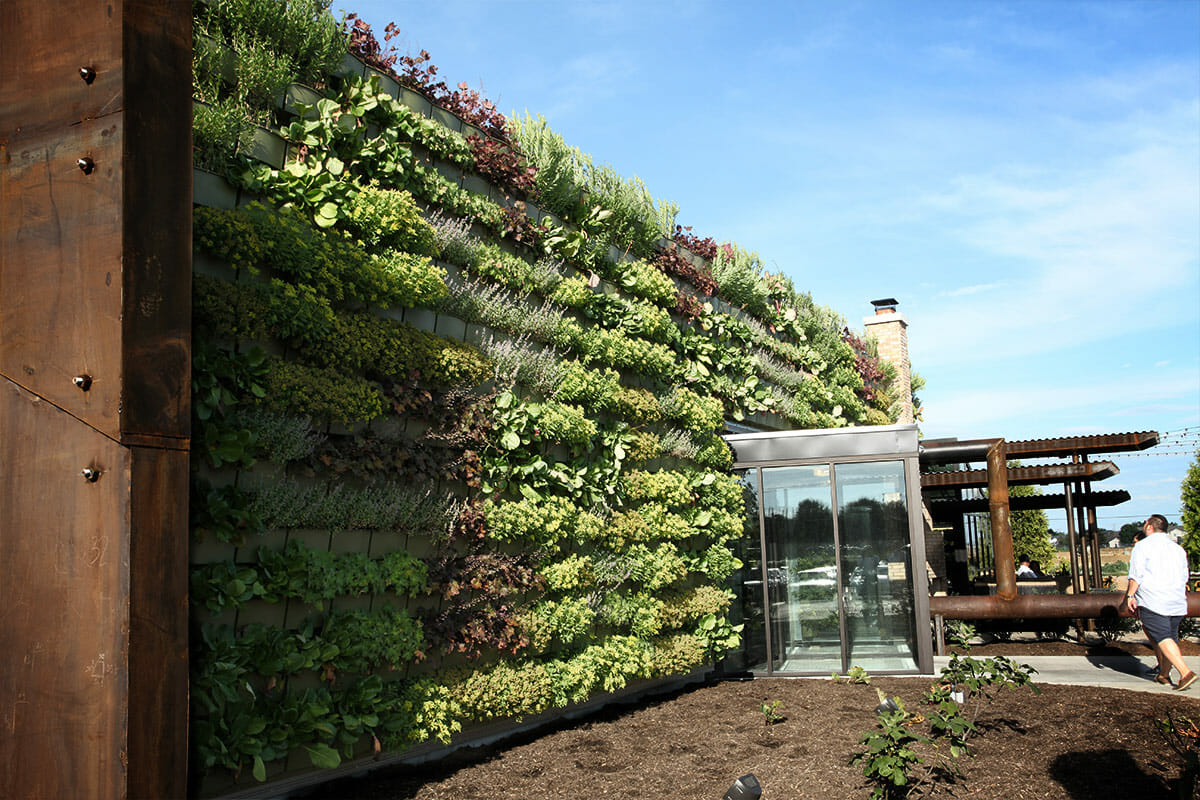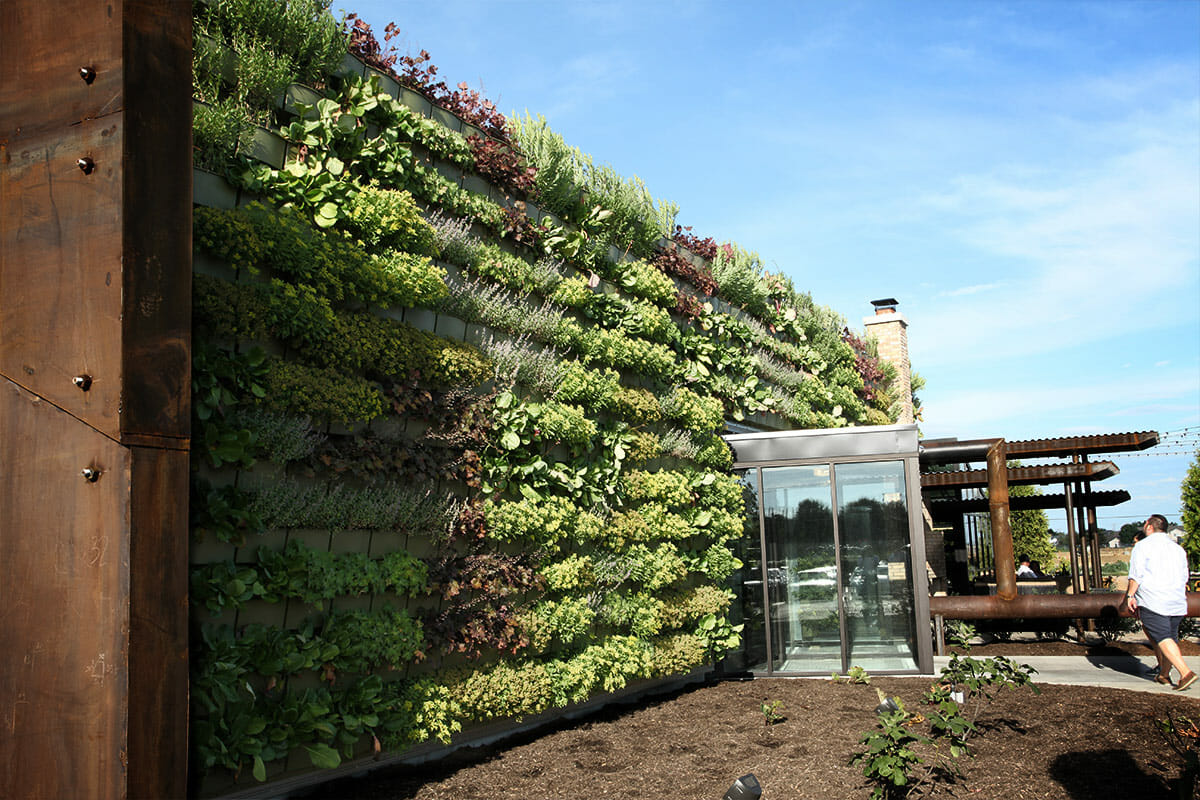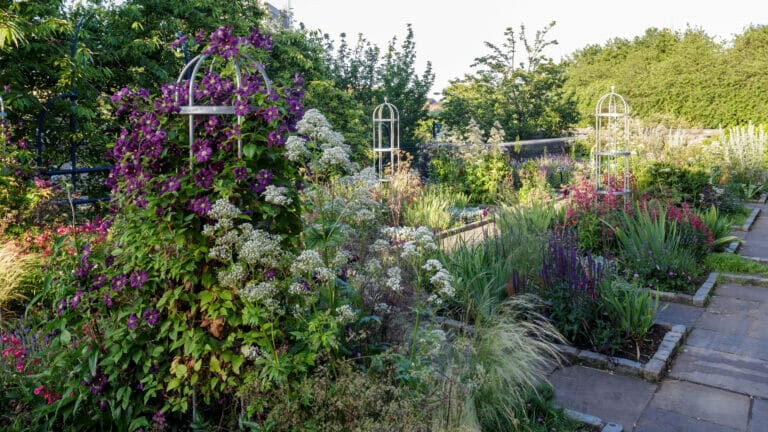
Can perennials be grown in vertical gardens? If you’ve ever wondered about the possibility of cultivating beautiful, long-lasting plants in your vertical garden, you’re in for a treat! Vertical gardens have become increasingly popular for their space-saving and aesthetic advantages.
But can perennials, which are plants that live for more than two years, thrive in this unique gardening setup? Let’s explore this fascinating topic together.
Vertical gardens offer a vertical twist on traditional gardening, where plants grow vertically instead of horizontally.
They are like living walls, adding a touch of greenery to any indoor or outdoor space. But when it comes to selecting plants for your vertical garden, you might be inclined to think only of smaller annuals or colorful annual flowers. That’s where the idea of growing perennials comes in – to challenge the norm and open up new possibilities.
The good news is that yes, perennials can indeed be grown in vertical gardens! While many vertical gardens feature annual plants, perennials can offer longer-term beauty.
Imagine vibrant vines climbing up a trellis or cascading foliage that changes colors with the seasons – it’s a visual delight. So, let’s explore the world of perennials and how they can bring a touch of perennial magic to your vertical garden. Let’s get started!

Can Perennials be Grown in Vertical Gardens?
Vertical gardens are typically designed for annual plants, but with some planning and care, perennials can thrive in vertical gardens too.
Choose perennials that have compact growth habits and don’t require a lot of root space. Opt for trailing perennials like creeping thyme or creeping jenny, or compact varieties of flowering plants like daylilies or hostas.
Ensure adequate soil depth and moisture retention, and regularly prune to control size. With these considerations, perennials can indeed be grown successfully in vertical gardens.
Benefits of Growing Perennials in Vertical Gardens
Perennials are plants that live for more than two years, meaning they can bring long-lasting beauty to your vertical garden. By incorporating perennials, you can create a garden that evolves and flourishes year after year, adding a touch of permanence to your vertical oasis.
One of the main advantages of growing perennials in vertical gardens is the variety of choices available. Perennials come in a wide range of colors, sizes, and textures, allowing you to create a diverse and visually stunning display. Additionally, many perennials are known for their ability to attract pollinators, such as butterflies and bees, which can contribute to the overall health of your garden ecosystem.
Another benefit of growing perennials in vertical gardens is the potential for creating a low-maintenance landscape. Perennials typically require less care than annuals, as they are more resilient and have established root systems. Once established, they can withstand harsh weather conditions and require less frequent watering and fertilizing. This can be particularly beneficial for those with busy schedules or limited gardening experience.
Tips for Growing Perennials in Vertical Gardens
While growing perennials in vertical gardens can be rewarding, it is important to consider a few key factors to ensure their success. Here are some tips to help you get started:
1. Select the Right Perennials: Choose perennials that are suited to your specific climate and growing conditions. Consider factors such as sunlight exposure, soil moisture, and temperature fluctuations. Some popular perennials for vertical gardens include creeping phlox, sedums, and ferns.
2. Provide Adequate Support: Perennials in vertical gardens may require additional support to prevent them from sagging or bending under their own weight. Install trellises, stakes, or netting to provide structural support for the plants as they grow.
3. Ensure Proper Drainage: Proper drainage is crucial for the success of perennials in vertical gardens. Make sure your vertical garden system has adequate drainage holes or a layer of gravel at the bottom to prevent waterlogging. Excess moisture can lead to root rot and other fungal diseases.
4. Consider Planting Depth: Different perennials have varying root depths, so it’s important to choose plants that are suitable for your vertical garden system. Some perennials may require deeper pockets or containers to accommodate their root systems.
By following these tips, you can create an environment that allows perennials to thrive and bring beauty to your vertical garden for years to come.
Challenges of Growing Perennials in Vertical Gardens
While growing perennials in vertical gardens can be rewarding, it is not without its challenges. Some common challenges include:
1. Limited Space for Root Development: Vertical garden systems typically have limited soil space, which can restrict the root development of perennials. This can impact their overall growth and vigor. It is important to select perennials that have shallow root systems or adapt well to confined spaces.
2. Watering and Nutrient Distribution: Watering and nutrient distribution can be more challenging in vertical gardens compared to traditional gardens. Perennials need adequate water and nutrients to thrive, so it’s essential to regularly monitor their moisture levels and fertilize accordingly.
3. Potential for Overcrowding: As perennials grow and spread, they can potentially overcrowd the vertical garden system. This can lead to competition for resources and hinder the growth of other plants. Regular pruning and dividing of perennials may be necessary to maintain a balanced and healthy garden.
Despite these challenges, with proper planning and care, it is possible to grow perennials successfully in vertical gardens, adding an element of longevity and beauty to your green space.
Vertical Gardens
Vertical gardening has revolutionized the way we approach gardening, offering a space-saving solution and an aesthetically pleasing way to cultivate plants.
It allows us to transform smaller spaces into vibrant displays of nature, while also providing numerous benefits for both the environment and the gardener. Let’s explore the world of vertical gardens and the reasons behind their growing popularity.
The Rise of Vertical Gardens
Vertical gardens, also known as green walls or living walls, have gained significant popularity in recent years. Originally popularized by renowned French botanist and artist Patrick Blanc, vertical gardens have become a symbol of modern urban design and sustainability.
With urban spaces becoming increasingly limited, vertical gardening offers a way to utilize vertical surfaces, such as walls and fences, to grow plants.
This not only maximizes the use of space but also adds an element of natural beauty to urban environments. Vertical gardens can be found in a variety of settings, from commercial buildings and shopping centers to private residences and public parks.
The Benefits of Vertical Gardening
There are numerous benefits associated with vertical gardening, making it a compelling choice for both avid gardeners and newcomers to the world of horticulture. Some key benefits include:
1. Maximizing Space: Vertical gardens allow individuals with limited space, such as small balconies or urban apartments, to enjoy the beauty and benefits of gardening. By utilizing vertical surfaces, gardeners can create lush greenery without sacrificing valuable floor space.
2. Improved Air Quality: Plants play a crucial role in purifying the air by absorbing carbon dioxide and releasing oxygen. Vertical gardens contribute to the improvement of air quality by increasing the overall number of plants in a given area.
3. Noise and Dust Reduction: Vertical gardens can act as natural barriers, helping to reduce noise pollution in urban environments. The plants absorb sound waves, creating a quieter and more peaceful atmosphere. Additionally, the foliage of vertical gardens can trap and filter dust particles, improving air quality in the surrounding area.
4. Insulation and Energy Efficiency: Vertical gardens have been shown to provide insulation properties, acting as a buffer against extreme temperatures. This can lead to energy savings by reducing the need for heating and cooling in buildings.
5. Increased Biodiversity: Vertical gardens provide habitats for various species of plants, insects, and birds, enhancing the overall biodiversity of urban areas. This promotes a healthier ecosystem and contributes to the preservation of biodiversity in the face of urbanization.
With these benefits in mind, it’s no wonder that vertical gardens have captured the imagination of garden enthusiasts and urban planners alike.
Vertical Gardens for Small Spaces: Bringing Nature Indoors
Vertical gardens have transformed the way we think about gardening, allowing us to turn small spaces into lush green sanctuaries. Whether you have a tiny apartment or a compact backyard, vertical gardens offer a solution for adding greenery and beauty to your surroundings.
In this section, we’ll explore the possibilities of vertical gardens for small spaces and provide tips for creating your own indoor green oasis.
Benefits of Vertical Gardens for Small Spaces
Small spaces often pose a challenge when it comes to incorporating nature and greenery. However, vertical gardens provide a solution by utilizing vertical surfaces, such as walls, to create a thriving garden in even the tiniest of spaces. Here are some benefits of vertical gardens for small spaces:
1. Maximizing Space: One of the main advantages of vertical gardens is their ability to maximize space. By utilizing vertical surfaces, you can create a garden that doesn’t take up valuable floor space. This is particularly beneficial for small apartments, balconies, or even office cubicles.
2. Improving Indoor Air Quality: Indoor air quality is a growing concern, especially in urban environments. Vertical gardens act as natural air filters by absorbing carbon dioxide and releasing oxygen. This can lead to cleaner and healthier indoor air, reducing the risk of respiratory problems and creating a more pleasant living or working environment.
3. Adding Beauty and Visual Interest: Small spaces can often feel dull and uninspiring. Vertical gardens can transform these spaces into vibrant displays of nature, adding beauty, texture, and color. Whether you choose cascading ivy, blooming flowers, or lush foliage, a vertical garden can create a stunning focal point in any small space.
Tips for Creating a Vertical Garden in a Small Space
Creating a vertical garden in a small space requires careful planning and consideration. Here are some tips to help you get started:
1. Choose the Right Plants: Select plants that are well suited to your specific conditions. Consider factors such as light levels, humidity, and temperature. Some easy-to-care-for plants for small vertical gardens include pothos, spider plants, and succulents.
2. Opt for Vertical Planters: Use vertical planters or wall-mounted containers to maximize space. There are a variety of options available, including pocket planters, hanging planters, and modular systems. Choose a design that compliments your style and fits the available space.
3. Create a Balanced Design: When designing your vertical garden, consider the overall aesthetics and balance of the space. Combine plants of varying heights, colors, and textures to create a visually appealing display. Don’t be afraid to experiment and get creative with plant placement.
4. Provide Adequate Lighting: Ensure that your vertical garden receives sufficient light for the plants to thrive. If you have limited natural light, consider using grow lights or positioning your vertical garden near a window.
5. Regular Maintenance and Care: Like any garden, vertical gardens require regular maintenance. This includes watering, fertilizing, and pruning as needed. Be mindful of the specific needs of your chosen plants and provide the necessary care to keep them healthy and flourishing.
By following these tips, you can create a stunning vertical garden in even the smallest of spaces, bringing nature indoors and elevating the aesthetics of your surroundings.
The answer to the question “Can perennials be grown in vertical gardens?” is a resounding yes. Perennials can be successfully grown in vertical gardens, offering long-lasting beauty and a low-maintenance landscape.
By carefully selecting the right perennials, providing adequate support, ensuring proper drainage, and overcoming potential challenges, you can create a thriving vertical garden that adds a touch of permanence to your green space.
Whether you have a large vertical garden or a small indoor space, the possibilities of incorporating perennials into your vertical garden are endless. So, get started and embark on your vertical gardening journey today!
Frequently Asked Questions
Welcome to our FAQ section! Here, we’ll address some common questions about growing perennials in vertical gardens. Whether you’re a seasoned gardener or a beginner looking to try something new, we’ve got you covered.
1. What are perennials, and can they be grown in vertical gardens?
Perennials are plants that live for more than two years, often coming back to life each spring. They are a popular choice for gardens due to their hardiness and ability to add beauty year after year.
The good news is that many perennials can be grown successfully in vertical gardens! However, it’s important to select the right species that can thrive in more confined spaces.
Look for compact varieties or those that are naturally more upright in their growth habit, as they will be better suited to vertical gardening.
Some examples of perennials that do well in vertical gardens include ferns, vine-like plants such as clematis or honeysuckle, and herbs like thyme or oregano. Before planting, make sure to do your research and choose species that will flourish in your specific growing conditions.
2. How do I prepare my vertical garden for growing perennials?
Preparing your vertical garden for perennials starts with selecting the right structure. Make sure it is sturdy and can support the weight of the plants as they grow.
Next, consider the soil. Perennials typically prefer well-draining soil, so ensure your vertical garden has adequate drainage systems in place. It’s also a good idea to amend the soil with organic matter before planting to improve its fertility.
Once your garden is set up, it’s time to plant the perennials. Follow the recommended planting depth and spacing for each species.
Water them thoroughly after planting and monitor the moisture levels regularly. Some vertical gardens may require more frequent watering due to their unique structure and exposure to air. Stay attentive to the needs of your specific plants, and provide them with ample sunlight to thrive.
3. Can I grow all types of perennials in a vertical garden?
While many perennials can be grown in vertical gardens, not all species are suitable for this type of gardening. Some perennials, such as large shrubs or trees, may be too heavy or extensive in their root system to thrive in a vertical garden setting.
It’s best to choose compact or vining perennials that are naturally more suited to vertical growth. Additionally, consider the amount of sunlight your vertical garden receives, as some perennials may require full sun exposure to flourish.
Remember to research the specific requirements of each perennial you wish to grow and assess whether they align with the conditions in your vertical garden. By selecting the right plants, you can create a stunning vertical garden that showcases a variety of colorful and long-lasting perennials.
4. How do I care for perennials in a vertical garden?
Caring for perennials in a vertical garden involves regular maintenance and attention to their specific needs. Start by monitoring the soil moisture levels and watering as necessary, ensuring that the plants receive adequate hydration without becoming waterlogged.
Deadheading or removing spent flowers can promote new growth and ensure the plants continue to bloom throughout the season.
Fertilizing is also essential to keep your perennials healthy. Apply a balanced slow-release fertilizer according to the package instructions, or opt for organic alternatives if preferred.
Additionally, check for any signs of pests or diseases, and take appropriate measures to prevent or treat them. Regular pruning may be necessary to control the growth and shape of your perennials, especially for vining varieties.
5. Can I overwinter perennials in a vertical garden?
Overwintering perennials in a vertical garden can be challenging, especially in regions with harsh winters. The exposure to cold temperatures and limited protection from the elements can make it difficult for perennials to survive. However, there are steps you can take to increase your chances of making it through the winter.
Consider insulating the vertical garden using materials like burlap or bubble wrap to provide some extra protection. Mulching the soil around the plants can also help to regulate temperatures and provide insulation to their root systems.
Additionally, relocating the vertical garden to a more sheltered area, such as against a south-facing wall, can offer some relief from the winter weather.
It’s important to note that not all perennials will tolerate winter conditions equally, so it’s crucial to choose cold-hardy species for your vertical garden. Alternatively, you may opt to transfer the perennials to a more protected area, such as a greenhouse, during the winter months to ensure their survival.
Perennials, like flowers and vegetables that last for more than two years, can indeed be grown in vertical gardens. Vertical gardens provide more space and allow perennials to grow upward, saving space on the ground. It’s important to choose the right type of perennials that are suitable for vertical growth.
The key is to select perennials with strong stems and shallow root systems, like herbs, strawberries, and flowers such as petunias. These plants can thrive in vertical gardens and provide a beautiful and practical addition to any outdoor space. With some care and maintenance, perennials can bring color and life to your vertical garden for many years to come.



